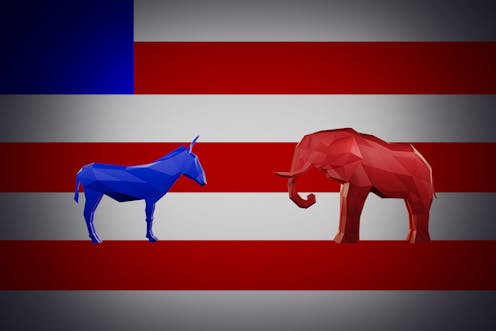Why do voters have to pick a Republican or a Democrat in the US?
- Written by Christopher Devine, Assistant Professor of Political Science, University of Dayton

The same logic explains why the U.S. has a two-party system. When there can be only one winner, and the winner is whoever gets the most votes, people with similar but not identical preferences have good reason to find common ground and work together – or else they’ll lose. They must try to build a coalition of voters that is bigger than any other. In turn, that group’s opponents will try to counter by enlarging their own coalition.
Thus, the rules for voting dictate that we end up with two large “parties” competing to be big enough to win the next election. While other options exist, many voters decide to pick between the only two that can win.
It doesn’t have to be Republican vs. Democrat
While a Democrat or Republican wins most elections in the United States, that doesn’t mean voters can only have two choices. Consider these three points.
First, the U.S. Constitution[15] does not allow for only two political parties. In fact, the Constitution says nothing at all about parties. Many of the Founding[16] Fathers[17] were skeptical of such “factions[18],” fearing that they would divide the American people and serve the interests of ambitious politicians. Yet many of those same visionaries soon helped to form the first political parties[19], after realizing the importance of coordinating with like-minded people to win elections and advance a common policy agenda. With a few[20] brief[21] exceptions[22], the United States has had a two-party system ever since.
Second, plenty of candidates run for office every year as something other than a Republican or Democrat. These include independents[24] who are not affiliated with any party or minor-party[25] nominees – for instance, from the Libertarian or Green Party. It’s just that these candidates typically do not garner many votes[26] and rarely[27] win an election[28].
Take the nation’s third-largest political party, the Libertarian Party. As my research[29] shows, Libertarians generally agree with the Republican Party on economic issues and the Democratic Party on social issues. This makes the Libertarian Party appealing to some voters who consider themselves fiscally conservative and socially liberal[30].
Third, in states such as California that have a top-two primary[31] system, elections sometimes come down to two candidates from the same party. This process begins with an open primary in which voters may choose among multiple candidates from various parties at the same time. The top two vote-getters go on to the general election months later – even if they are both Democrats[32] or Republicans[33].
Other states, such as Maine[34] and Alaska[35], use ranked-choice voting[36]. This system allows voters to rank all candidates[37] – Democratic, Republican, independent or minor party – from their favorite to least favorite on the same ballot. The winner is whichever candidate gets more than 50% of the vote, either at first or after eliminating the last-place finisher and reallocating[38] that candidate’s voters to their second-choice candidates.
So voters often do have more options than simply Democrat vs. Republican. The problem is that people feel as if only one party or the other has a chance to win – and cast their votes accordingly. It all comes down to the rules for running elections. If you want more choices, you’ll have to change those rules.
Hello, curious kids! Do you have a question you’d like an expert to answer? Ask an adult to send your question to CuriousKidsUS@theconversation.com[39]. Please tell us your name, age and the city where you live.
And since curiosity has no age limit – adults, let us know what you’re wondering, too. We won’t be able to answer every question, but we will do our best.
References
- ^ Curious Kids (theconversation.com)
- ^ curiouskidsus@theconversation.com (theconversation.com)
- ^ president (www.nytimes.com)
- ^ governor (www.nytimes.com)
- ^ mayor (www.nytimes.com)
- ^ political scientist (www.christopherjdevine.com)
- ^ political (www.washingtonpost.com)
- ^ parties (www.washingtonpost.com)
- ^ Libertarian (doi.org)
- ^ Party (kansaspress.ku.edu)
- ^ Duverger’s (www.worldcat.org)
- ^ law (www.youtube.com)
- ^ Single-winner (ballotpedia.org)
- ^ Tetra Images via Getty Images (www.gettyimages.com)
- ^ U.S. Constitution (www.archives.gov)
- ^ Founding (www.govinfo.gov)
- ^ Fathers (founders.archives.gov)
- ^ factions (guides.loc.gov)
- ^ first political parties (www.pbs.org)
- ^ few (www.presidency.ucsb.edu)
- ^ brief (www.presidency.ucsb.edu)
- ^ exceptions (www.presidency.ucsb.edu)
- ^ Hill Street Studios/DigitalVision via Getty Images (www.gettyimages.com)
- ^ independents (ballotpedia.org)
- ^ minor-party (www.politics1.com)
- ^ typically do not garner many votes (fairvote.org)
- ^ rarely (ballotpedia.org)
- ^ an election (my.lp.org)
- ^ my research (udayton.edu)
- ^ fiscally conservative and socially liberal (time.com)
- ^ top-two primary (ballotpedia.org)
- ^ Democrats (www.losaltosonline.com)
- ^ Republicans (calmatters.org)
- ^ Maine (www.nytimes.com)
- ^ Alaska (www.nytimes.com)
- ^ ranked-choice voting (www.youtube.com)
- ^ allows voters to rank all candidates (theconversation.com)
- ^ eliminating the last-place finisher and reallocating (theconversation.com)
- ^ CuriousKidsUS@theconversation.com (theconversation.com)
Authors: Christopher Devine, Assistant Professor of Political Science, University of Dayton
Read more https://theconversation.com/why-do-voters-have-to-pick-a-republican-or-a-democrat-in-the-us-203830

